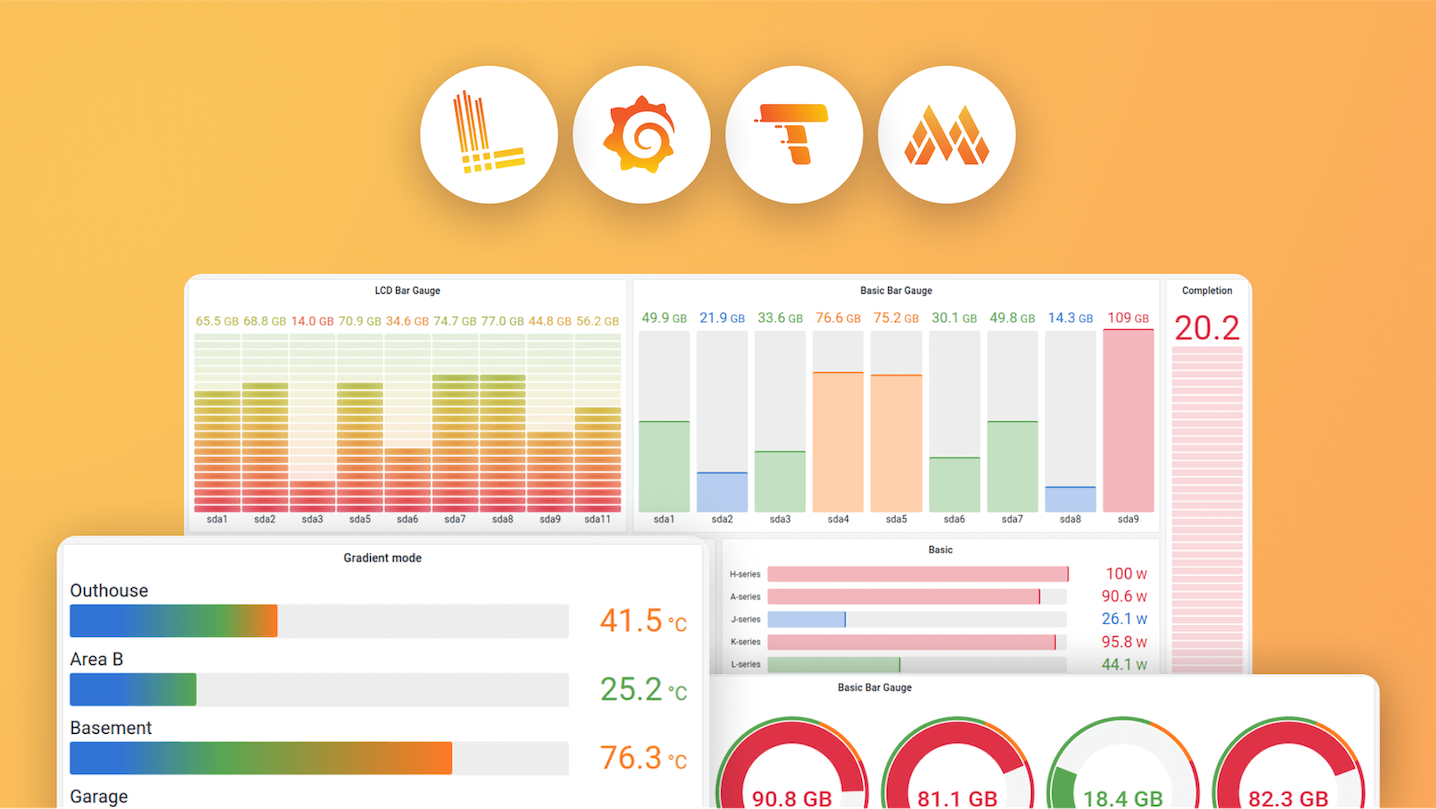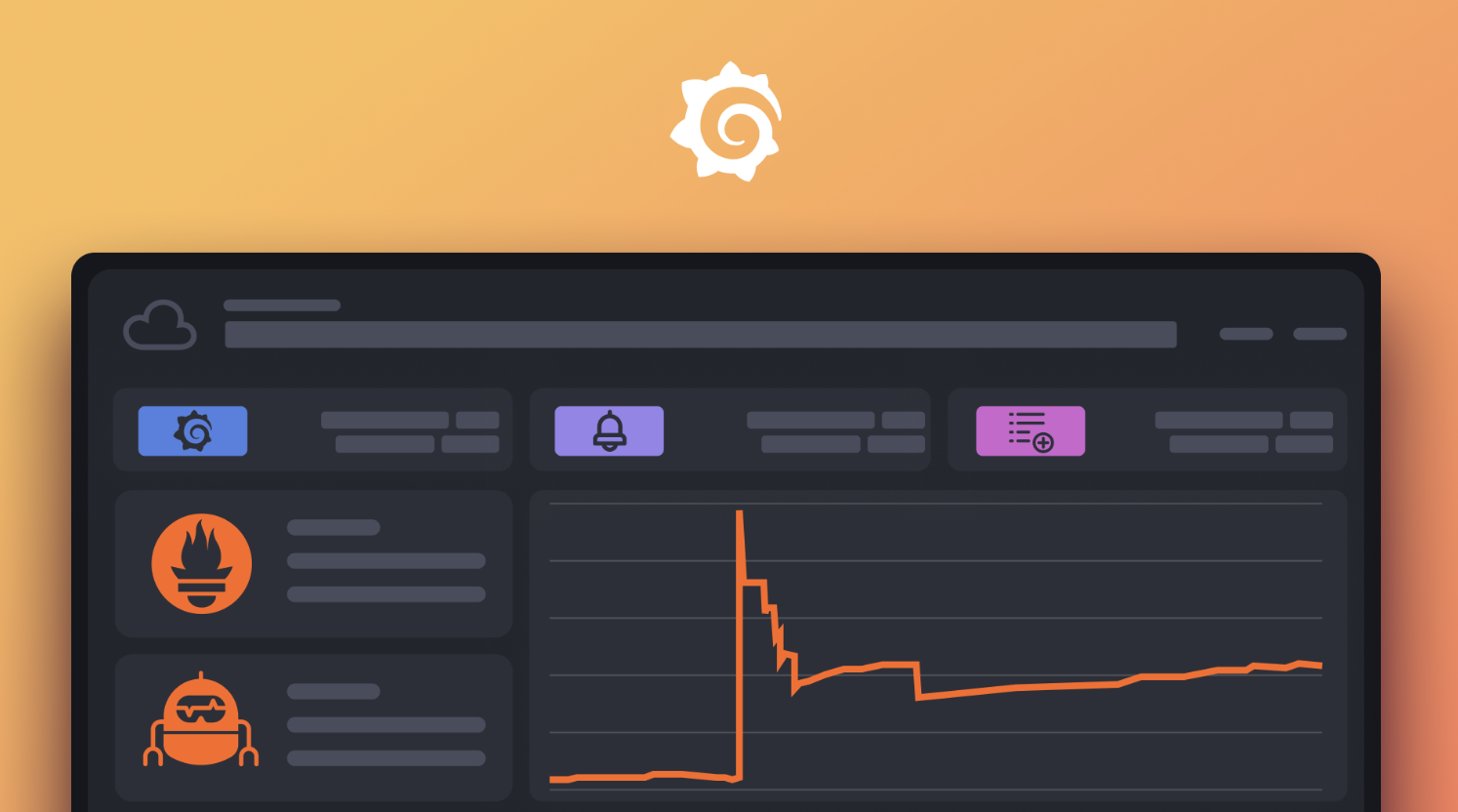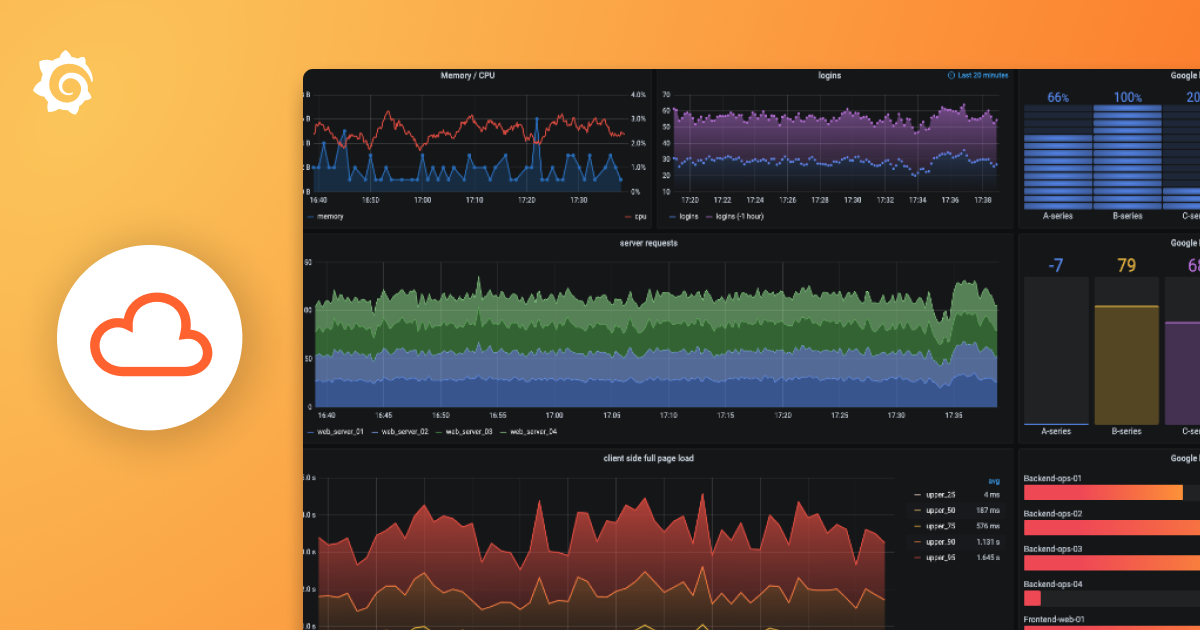Plugins 〉SimpleJson
SimpleJson
Simple JSON Datasource - a generic backend datasource
More documentation about datasource plugins can be found in the Docs.
This also serves as a living example implementation of a datasource.
Your backend needs to implement 4 urls:
/should return 200 ok. Used for "Test connection" on the datasource config page./searchused by the find metric options on the query tab in panels./queryshould return metrics based on input./annotationsshould return annotations.
Those two urls are optional:
/tag-keysshould return tag keys for ad hoc filters./tag-valuesshould return tag values for ad hoc filters.
Installation
To install this plugin using the grafana-cli tool:
sudo grafana-cli plugins install grafana-simple-json-datasource
sudo service grafana-server restart
See here for more information.
Example backend implementations
- https://github.com/bergquist/fake-simple-json-datasource
- https://github.com/smcquay/jsonds
- https://github.com/ContextLogic/eventmaster
- https://gist.github.com/linar-jether/95ff412f9d19fdf5e51293eb0c09b850 (Python/pandas backend)
Query API
Example timeserie request
{
"panelId": 1,
"range": {
"from": "2016-10-31T06:33:44.866Z",
"to": "2016-10-31T12:33:44.866Z",
"raw": {
"from": "now-6h",
"to": "now"
}
},
"rangeRaw": {
"from": "now-6h",
"to": "now"
},
"interval": "30s",
"intervalMs": 30000,
"targets": [
{ "target": "upper_50", "refId": "A", "type": "timeserie" },
{ "target": "upper_75", "refId": "B", "type": "timeserie" }
],
"adhocFilters": [{
"key": "City",
"operator": "=",
"value": "Berlin"
}],
"format": "json",
"maxDataPoints": 550
}
Example timeserie response
[
{
"target":"upper_75", // The field being queried for
"datapoints":[
[622,1450754160000], // Metric value as a float , unixtimestamp in milliseconds
[365,1450754220000]
]
},
{
"target":"upper_90",
"datapoints":[
[861,1450754160000],
[767,1450754220000]
]
}
]
If the metric selected is "type": "table", an example table response:
[
{
"columns":[
{"text":"Time","type":"time"},
{"text":"Country","type":"string"},
{"text":"Number","type":"number"}
],
"rows":[
[1234567,"SE",123],
[1234567,"DE",231],
[1234567,"US",321]
],
"type":"table"
}
]
Annotation API
The annotation request from the Simple JSON Datasource is a POST request to
the /annotations endpoint in your datasource. The JSON request body looks like this:
{
"range": {
"from": "2016-04-15T13:44:39.070Z",
"to": "2016-04-15T14:44:39.070Z"
},
"rangeRaw": {
"from": "now-1h",
"to": "now"
},
"annotation": {
"name": "deploy",
"datasource": "Simple JSON Datasource",
"iconColor": "rgba(255, 96, 96, 1)",
"enable": true,
"query": "#deploy"
}
}
Grafana expects a response containing an array of annotation objects in the following format:
[
{
annotation: annotation, // The original annotation sent from Grafana.
time: time, // Time since UNIX Epoch in milliseconds. (required)
title: title, // The title for the annotation tooltip. (required)
tags: tags, // Tags for the annotation. (optional)
text: text // Text for the annotation. (optional)
}
]
Note: If the datasource is configured to connect directly to the backend, you
also need to implement an OPTIONS endpoint at /annotations that responds
with the correct CORS headers:
Access-Control-Allow-Headers:accept, content-type
Access-Control-Allow-Methods:POST
Access-Control-Allow-Origin:*
Search API
Example request
{ target: 'upper_50' }
The search api can either return an array or map.
Example array response
["upper_25","upper_50","upper_75","upper_90","upper_95"]
Example map response
[ { "text" :"upper_25", "value": 1}, { "text" :"upper_75", "value": 2} ]
Tag Keys API
Example request
{ }
The tag keys api returns:
[
{"type":"string","text":"City"},
{"type":"string","text":"Country"}
]
Tag Values API
Example request
{"key": "City"}
The tag values api returns:
[
{'text': 'Eins!'},
{'text': 'Zwei'},
{'text': 'Drei!'}
]
Dev setup
This plugin requires node 6.10.0
npm install -g yarn
yarn install
npm run build
Changelog
1.4.1
- Fix for query editor to be compatible with Grafana 7+ (broke due to change in Grafana).
1.4.0
- Support for adhoc filters:
- added tag-keys + tag-values api
- added adHocFilters parameter to query body
1.3.5
- Fix for dropdowns in query editor to allow writing template variables (broke due to change in Grafana).
1.3.4
- Adds support for With Credentials (sends grafana cookies with request) when using Direct mode
- Fix for the typeahead component for metrics dropdown (
/searchendpoint).
1.3.3
- Adds support for basic authentication
1.2.4
- Add support returning sets in the search endpoint
1.2.3
- Allow nested templates in find metric query. #23
1.2.2
- Dont execute hidden queries
- Template support for metrics queries
- Template support for annotation queries
If using Grafana 2.6
NOTE! for grafana 2.6 please use this version
Copy the data source you want to /public/app/plugins/datasource/. Then restart grafana-server. The new data source should now be available in the data source type dropdown in the Add Data Source View.
Grafana Cloud Free
- Free tier: Limited to 3 users
- Paid plans: $55 / user / month above included usage
- Access to all Enterprise Plugins
- Fully managed service (not available to self-manage)
Self-hosted Grafana Enterprise
- Access to all Enterprise plugins
- All Grafana Enterprise features
- Self-manage on your own infrastructure
Grafana Cloud Free
- Free tier: Limited to 3 users
- Paid plans: $55 / user / month above included usage
- Access to all Enterprise Plugins
- Fully managed service (not available to self-manage)
Self-hosted Grafana Enterprise
- Access to all Enterprise plugins
- All Grafana Enterprise features
- Self-manage on your own infrastructure
Grafana Cloud Free
- Free tier: Limited to 3 users
- Paid plans: $55 / user / month above included usage
- Access to all Enterprise Plugins
- Fully managed service (not available to self-manage)
Self-hosted Grafana Enterprise
- Access to all Enterprise plugins
- All Grafana Enterprise features
- Self-manage on your own infrastructure
Grafana Cloud Free
- Free tier: Limited to 3 users
- Paid plans: $55 / user / month above included usage
- Access to all Enterprise Plugins
- Fully managed service (not available to self-manage)
Self-hosted Grafana Enterprise
- Access to all Enterprise plugins
- All Grafana Enterprise features
- Self-manage on your own infrastructure
Grafana Cloud Free
- Free tier: Limited to 3 users
- Paid plans: $55 / user / month above included usage
- Access to all Enterprise Plugins
- Fully managed service (not available to self-manage)
Self-hosted Grafana Enterprise
- Access to all Enterprise plugins
- All Grafana Enterprise features
- Self-manage on your own infrastructure
Installing SimpleJson on Grafana Cloud:
Installing plugins on a Grafana Cloud instance is a one-click install; same with updates. Cool, right?
Note that it could take up to 1 minute to see the plugin show up in your Grafana.
Installing plugins on a Grafana Cloud instance is a one-click install; same with updates. Cool, right?
Note that it could take up to 1 minute to see the plugin show up in your Grafana.
Installing plugins on a Grafana Cloud instance is a one-click install; same with updates. Cool, right?
Note that it could take up to 1 minute to see the plugin show up in your Grafana.
Installing plugins on a Grafana Cloud instance is a one-click install; same with updates. Cool, right?
Note that it could take up to 1 minute to see the plugin show up in your Grafana.
Installing plugins on a Grafana Cloud instance is a one-click install; same with updates. Cool, right?
Note that it could take up to 1 minute to see the plugin show up in your Grafana.
Installing plugins on a Grafana Cloud instance is a one-click install; same with updates. Cool, right?
Note that it could take up to 1 minute to see the plugin show up in your Grafana.
Installing plugins on a Grafana Cloud instance is a one-click install; same with updates. Cool, right?
Note that it could take up to 1 minute to see the plugin show up in your Grafana.
For more information, visit the docs on plugin installation.
Installing on a local Grafana:
For local instances, plugins are installed and updated via a simple CLI command. Plugins are not updated automatically, however you will be notified when updates are available right within your Grafana.
1. Install the Data Source
Use the grafana-cli tool to install SimpleJson from the commandline:
grafana-cli plugins install The plugin will be installed into your grafana plugins directory; the default is /var/lib/grafana/plugins. More information on the cli tool.
Alternatively, you can manually download the .zip file for your architecture below and unpack it into your grafana plugins directory.
Alternatively, you can manually download the .zip file and unpack it into your grafana plugins directory.
2. Configure the Data Source
Accessed from the Grafana main menu, newly installed data sources can be added immediately within the Data Sources section.
Next, click the Add data source button in the upper right. The data source will be available for selection in the Type select box.
To see a list of installed data sources, click the Plugins item in the main menu. Both core data sources and installed data sources will appear.



